
Thomas Boleyn, Earl of Wiltshire, 1st Earl of Ormond, 1st Viscount RochfordKGKB, of Hever Castle in Kent, was an English diplomat and politician who was the father of Anne Boleyn, the second wife of King Henry VIII, and was thus the maternal grandfather of Queen Elizabeth I. By Henry VIII he was made a knight of the Garter in 1523 and was elevated to the peerage as Viscount Rochford in 1525 and in 1529 was further ennobled as Earl of Wiltshire and Earl of Ormond.
Duke of Buckingham, referring to Buckingham, is a title that has been created several times in the peerages of England, Great Britain, and the United Kingdom. There were creations of double dukedoms of Buckingham and Normanby and of Buckingham and Chandos. The last holder of the dukedom died in 1889 and the title is currently extinct.

William Longespée, 3rd Earl of Salisbury was an Anglo-Norman nobleman, primarily remembered for his command of the English forces at the Battle of Damme and for remaining loyal to his half-brother, King John. His nickname "Longespée" is generally taken as a reference to his great physical height and the oversize weapons that he used.

Marquess of Winchester is a title in the Peerage of England that was created in 1551 for the prominent statesman William Paulet, 1st Earl of Wiltshire. It is the oldest of six surviving English marquessates; therefore its holder is considered the premier marquess of England. It is also now the only marquessate in the Peerage of England not being subsidiary to a higher title. The current holder is Christopher Paulet, 19th Marquess of Winchester, whose son uses the courtesy title Earl of Wiltshire.

Earl of Lincoln is a title that has been created eight times in the Peerage of England, most recently in 1572. The title was borne by the Dukes of Newcastle-under-Lyne from 1768 to 1988, until the dukedom became extinct.

Earl of Salisbury is a title that has been created several times in English and British history. It has a complex history, and is now a subsidiary title to the marquessate of Salisbury.
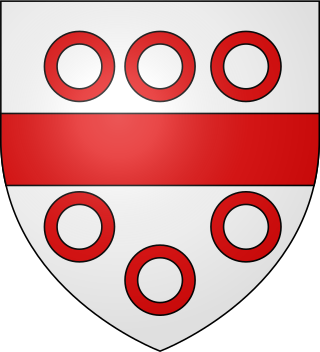
Baron Lucas is a title that has been created twice in the Peerage of England. The second creation is extant and is currently held with the title Lord Dingwall in the Peerage of Scotland.

Baron Stafford, referring to the town of Stafford, is a title that has been created several times in the Peerage of England. In the 14th century, the barons of the first creation were made earls. Those of the fifth creation, in the 17th century, became first viscounts and then earls. Since 1913, the title has been held by the Fitzherbert family.
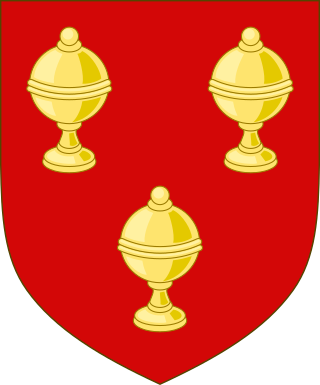
The peerage title Earl of Ormond and the related titles Duke of Ormonde and Marquess of Ormonde have a long and complex history. An earldom of Ormond has been created three times in the Peerage of Ireland.
Scrope is the name of an old English family of Norman origin that first came into prominence in the 14th century. The family has held the noble titles of Baron Scrope of Masham, Baron Scrope of Bolton, and for a brief time, the Earl of Wiltshire.
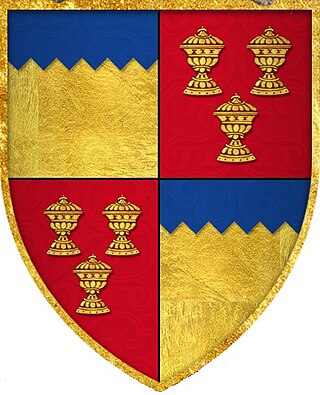
Piers Butler, 8th Earl of Ormond, 1st Earl of Ossory also known as Red Piers, was from the Polestown branch of the Butler family of Ireland. In the succession crisis at the death of Thomas Butler, 7th Earl of Ormond he succeeded to the earldom as heir male, but lost the title in 1528 to Thomas Boleyn. He regained it after Boleyn's death in 1538.
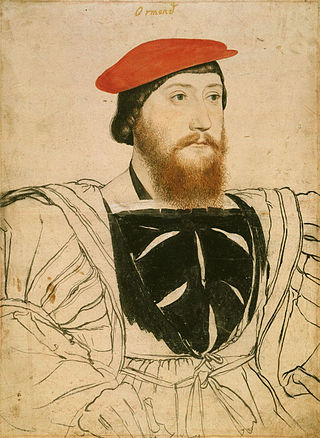
James Butler, 9th Earl of Ormond and 2nd Earl of Ossory, known as the Lame, was in 1541 confirmed as Earl of Ormond thereby ending the dispute over the Ormond earldom between his father, Piers Butler, 8th Earl of Ormond, and Thomas Boleyn, 1st Earl of Wiltshire. He died from poison in London.
Thomas Butler, 7th Earl of Ormond PC was the youngest son of James Butler, 4th Earl of Ormond. He was attainted, but restored by Henry VII's first Parliament in November 1485, and the statutes made at Westminster, by Edward IV, which declared him and his brothers traitors, were abrogated.

The titles Baron Montacute or Baron Montagu were created several times in the Peerage of England for members of the House of Montagu. The family name was Latinised to de Monte Acuto, meaning "from the sharp mountain"; the French form is an ancient spelling of mont aigu, with identical meaning.
Joan Holland was the third daughter of Thomas Holland, 2nd Earl of Kent, and Alice FitzAlan. She married four times. Her first husband was a duke, and the following three were barons. All of her marriages were most likely childless.

Earl of Ormond was a title twice created in the Peerage of Scotland, both times for members of the Douglas family. The related title Marquess of Ormond was created twice in the Peerage of Scotland for members of the House of Stuart.
William of Salisbury, 2nd Earl of Salisbury was an Anglo-Norman peer. Though he is generally known as such, his proper title was Earl of Wiltshire, which title was conferred on his father by the Empress Matilda around 1143. He was also called William FitzPatrick. He was the son and heir of Patrick of Salisbury, Earl of Wiltshire, styled Earl of Salisbury, and of Ela Talvas.
Ela of Salisbury, 3rd Countess of Salisbury was an English peeress. She succeeded to the title in her own right in 1196 upon the death of her father, William FitzPatrick, 2nd Earl of Salisbury.
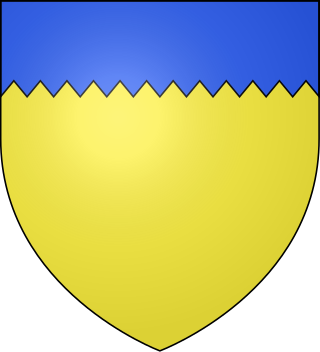
Butler is the name of a noble family whose members were, for several centuries, prominent in the administration of the Lordship of Ireland and the Kingdom of Ireland. They rose to their highest prominence as Dukes of Ormonde. The family has produced multiple titles such as Baron Cahir, Baron Dunboyne, Viscount Ikerrin, Viscount Galmoye, Viscount Mountgarret, Viscount Thurles, Earl of Carrick, Earl of Kilkenny, Earl of Ormond, Earl of Ossory, Marquess of Ormonde and Duke of Ormonde. Variant spellings of the name include le Boteler and le Botiller. The Butlers were descendants of Anglo-Norman lords who participated in the Norman invasion of Ireland in the 12th century. The surname has its origins in the hereditary office of "Butler (cup-bearer) of Ireland", originating with Theobald Walter, 1st Chief Butler of Ireland. The arms of later family members depicted three cups in recognition of their original office.
Margaret Longespée, 4th Countess of Salisbury was an English noblewoman.